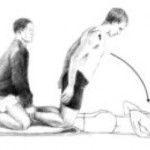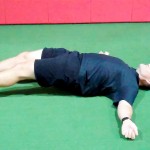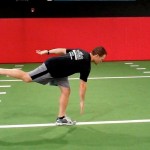Brian Schiff’s Blog
Injury Prevention, Sports Rehab & Performance Training Expert
Perhaps one of the most researched topics is ACL injuries. I have been studying and working for years in my clinical practice to find the best ways to rehab athletes following injury as well as implement the most effective injury prevention strategies. Prior studies indicate prevention programs even when self directed can be successful.
However, on the whole injury rates have not declined over the past decade or so. Much attention has been given to valgus landing mechanics, poor muscle firing, stiff landings, genetic difference between males and females, ligament dominance, quad dominance, and so forth. The predominant thoughts today for prevention center around neuromuscular training and eliminating faulty movement patterns (refer to work being done by Timothy Hewett and Darin Padua).
We also know from a biomechanical standpoint that the hamstrings play an integral role in preventing excess anterior tibial translation, and as such hamstring strengthening needs to be a big part of the rehab and prevention program. I believe in hamstring training that allows for activation in non-weaightbearing and weight bearing positions. Common exercises I will use include:
- HS bridging patterns (double /single leg, marching, knee extension, stability ball)
- Nordic HS curls
- HS curls (stability ball, TRX or machine)
- Sliders – focus on slow eccentric motion moving into knee extension followed by simultaneous curls/bridge
- Single leg RDL (add dumbbells or kettle bells for more load)
Note: click on any of the thumbnail images above for a full view of the exercise. From left to right: Nordic HS curls, sliding hamstring curls and single leg RDL).
A recent blog post entry by the UNC Department of Exercise and Sport Science (@UNCEXSS) has spurred my post today. Click here to read their entry on optimizing injury prevention based on work done by Professor Troy Blackburn regarding the effect of isometric and isotonic training on hamstring stiffness and ACL loading mechanisms. The research that was done holds promise for hamstring training designed to increased musculotendinous stiffness (MTS).
I had the pleasure of listening to Darin Padua, PhD, of UNC present some of his latest research on ACL injury prevention last week. He has been doing research for some time. One of his studies (JUMP ACL) in collaboration with the military and several others has looked at prospective data and injury occurrence among college age subjects.
Much of the research to date on injury prevention has been done by Timothy Hewett and his colleagues. It has concluded that drop landing with a valgus collapse (hip abduction/IR with valgus knee moment) is a risk factor for injury. Interstingly enough, despite that knowledge and the proliferation of prevention programs, Darin mentioned that overall these prevention programs have not slowed the rate of ACL tears in the last decade. Why is that? He also relayed that much of what we know now is based on 15 total cases.
The Jump ACL Study in a nutshell lasted for 5 years at 3 different military academies:
N = 5,700 cadets with no prior ACL surgery
- Soccer players = 1,690
- Tested from 2005 to 2008
- 39% female; 25% NCAA athletes
- 14,653 person-years of follow-up
N = 113 incident ACL injuries
- Soccer players = 29
- Mean time from testing to injury = 3.1 yrs
- N = 92 one ACL injury; N = 11 two ACL injuries
Some data (will be published) he discussed based on his findings revealed the following about high risk profiles for ACL injury:
- Hip flexion > 40 degrees at landing = 1.76x increased risk
- Hip adduction plus knee valgus = 3x increased risk
- Hip adduction plus knee varus = 27x increased risk
He also mentioned that the high risk profile does not correspond to the ACL injury event profile of:
- Hip abduction
- Lateral trunk flexion
- Knee valgus collapse
- Small knee flexion
- Tibial ER/IR
In the end, he suggests we need to better understand who to target (high risk profile clients) and what to modify (injury event profile) so we can better customize injury prevention programs that optimize proper movement and meet the needs of each individual athlete. He reminded us that using the uninjured side for comparison is insufficient as faulty movement patterns already likely existed contributing to the first ACL injury.
So, assessing movement continuously and striving for excellent movement quality is a MUST if we are going to both prevent initial ACL injuries and reduce the re-tear rates for our athletes we send back to play. He reports that those at increased risk simply have bad biomechanics. His message provides more weight to having an advanced algorithm to identify asymmetry, poor motor control and flawed movement patterns in order to effectively prescribe interventions to address these things.
At UNC they use a PRIME assessment. I am excited to learn more about it and have referred one of my female higher level soccer players to their lab for assessment as I look at this return to play decision with her now that she is just past 7 months post-op. I think the hip/core obviously play an important role as I see so much deficiency in my female patients recovering from injury.
Clearly his findings with hip adduction and varus as a big risk factor seem to indicate it could be a top down kinetic chain breakdown as well upon impact based on the risk profile. Pelvic stability or the lack thereof seems to be significant, only NOT in the same manner we thought about it before based on previous research available. Stay tuned, as we have lots more to learn about ACL injuries and how best to tailor our prevention efforts.
Over the past several years, the trend in the health and fitness industry has been toward injury prevention and movement screening. Gray Cook and Lee Burton have given us the FMS. More recently, the Y-Balance test has emerged as another tool to assess asymmetry in the upper and lower quarter.
I am currently FMS certified and planning to attend the SFMA course next month in Durham. I routinely incorporate the FMS in both our rehab and sports performance work at the APC. I like many things about the screening exam. It provides a consistent tool to assess baseline movement and record asymmetry on a simple 4 point scale scale. It also has been shown to have good intra and inter-rater reliability. Click here for a recent study published in the Journal or Orthopaedic & Sports Physical Therapy.
For those unfamiliar with the screen, it is 7 tests scored on a 0-3 scale as follows:
- 0 = pain
- 1 = unable to perform the movement pattern (or perform with marked dysfunction)
- 2 = performs the movement with a mild compensation
- 3 = performs the movement correctly
I would say on average, most of the athletes I screen score between a 12 and 15. My highest score was a 19 (9 year old gymnast) and my lowest was a 9 (NFL lineman). As screeners, we are charged with uncovering asymmetry and faulty movement patterns. What do you see in the following picture?
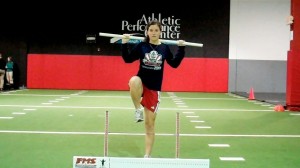
Clearly, the dowel is not level, thus we score it a 2. She also had some ER in the right leg when stepping over the hurdle. She was a symmetrical 2 on the hurdle step test. This is a Division I soccer player who scored 17 on the exam.
Most of the movements seem straightforward. However, many question what the rotary stability test measures with respect to the ideal 3 score (ipsilateral movement)? It assesses an unnatural movement pattern to be sure. This athlete failed miserably on the ipsilateral pattern but scored a solid 2 with the contralateral pattern.
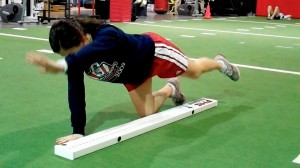
I have yet to test someone who can score a legitimate 3. I have seen some get a 3 on one side and 2 on the other (asymmetrical and a red flag in FMS land). As one who naturally questions things, I find myself questioning how many are truly capable of scoring a 3.
I just finished presenting at our our second ACL Symposium of the year at the Athletic Performance Center last Saturday. Rehabbing and training female athletes has been a passion of mine for some time. Over the years, I have also developed a love for research and reading it, particularly studies on the ACL.
In my practice, I have incorporated jump landing, single leg training and deceleration based training for some time. While we all know females are 3-8 times more likely to suffer an ACL injury than males, we have not isolated the exact reason why. Researchers have offered some clues such as: wider pelvis, narrow femoral notch, smaller ACL, ligament dominance, limb dominance, natural laxity (hormonal factors), wider Q angles, and faulty muscle firing patterns to name a few.
Many of the structural factors are beyond our control. So, as practitioners, we must focus on the training. Consider the following study just published in the August 2011 edition of the American Journal of Sports Medicine that basically reveals females develop peak valgus moments during deceleration during a drop landing maneuver, whereas males develop peak valgus forces during acceleration on the way back up:

Drop Landing
This article adds more evidence that females recruit and fire their muscles very differently than males. More importantly, it reiterates that we as coaches, therapists and S & C professionals need to be working on deceleration mechanics. I believe this starts with simple soft two legged drills such as:
- Small squat jump and holds
- Box drops and holds
- Forward line jump, stick and hold
- Lateral line jump, stick and hold
- 90 degree jump turn, stick and hold
In addition, one of my favorite drills is a single leg forward leap (hop) and stick working on deceleration. The athlete stands on the right leg and then pushes off forward landing on the left leg. Coaching the athlete to land softly on a bent hip and knee while avoiding valgus is important. I usually perform 2-3 sets of 5 reps on each side. Cueing with a mirror, auditory corrections and tactile cues are useful in encouraging proper form.

SL Stick (start)
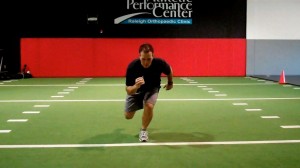
SL Stick (finish)
It is important to keep in mind that the majority of non-contact ACL tears occur between 0 and 30 degrees of knee flexion. They also typically involve deceleration (landing, jump stop or change of direction), planting or cutting. For this reason, deceleration training must also involve programming for agility and change of direction.
On Saturday, I led the break-out session on deceleration training and covered a few key exercises I use with my athletes. These drills are layered on one another and the basic ones I begin with are:
- Stops – I have athletes accelerate out and then decelerate to a controlled two legged stop after 10-20 yards. Keep in mind allowing for a longer run will allow the athlete to gradually slow down, while decreasing the distance increases intensity and force on the knees. I coach breaking down with small “pitter patter” steps versus a sudden hard stop.
- 2 cone lateral shuffle stops – the athlete shuffles over 5-6 yards and then stops with good hip, knee and foot alignment working to keep the shoulders inside the knees (inside the box). I progress to multiple cone shuffles to increase intensity and maximize repetitive deceleration.
- Pro-agility drills – 3 cones are placed 5 yards apart and I combine linear and lateral movements between the cones layering #1 and #2 above in a continuous pattern to work on acceleration/deceleration combos and change of direction
- Y drill (4 cones) – the athlete runs forward to a cone 5-15 yards out and then performs a 45 degree cut left/right. The progression begins with directed and predictable movement and then advances to reactive cueing with auditory and visual cues.
- Arrow drill (4 cones) – The athlete runs 5-15 yards forward and then performs a 135 degree cut left/right and runs past the cone that serves as the bottom edge of the arrow head. This is much more demanding on the body (knee) and as such I only move to this after the Y drill has been mastered. In addition, I teach a hip turn (from Lee Taft) to reposition the hips and minimize torsion on the lower leg. I move from predictive to reactive agility as in the Y drill.
These exercises are a small sampling of my ACL prehab/rehab routine. I also include an enormous amount of single leg PRE’s and balance training as well. I believe the most important things we can currently do to reduce ACL risk in this population are:
- Screen our athletes to help identify risk (FMS, drop landing, dynamic strength,running/cutting analysis)
- Emphasize hamstring, gluteus medius and lateral rotator strengthening
- Teach landing mechanics and proper deceleration through neuromuscular exercise, biofeedback and repetitive cueing
- Refine proper cutting technique by teaching ideal angles and how to reposition the hips
- Empower coaches and athletes with simple yet effective body weight training routines that can be replicated on the field or court with the team
For now, the battle rages on. I hope you will join me in the quest to prevent these catastrophic injuries. I think as research evolves we will continue to see that the answer to promoting optimal stability at the knee will increasingly have more to do with addressing the hip and ankle. For now, we need to teach soft bent knee landing/cutting that shifts the body’s center of mass forward, while eliminating valgus loading as much as possible in the danger zone.
For those who know me well, it is safe to say I am an “ACL geek” of sorts. I love studying, reading and searching for the best way to rehab and prevent these injuries. As I have grown in the profession, I have become increasingly concerned with articular cartilage damage and the long term effects it has on our young athletes.
Perhaps I am getting more concerned as my knees aren’t getting any younger either (lol). Anyway, I truly believe we often underestimate how deleterious cartilage injuries can be long term. In addition, I feel we, as rehab and conditioning professionals, need to better understand how our training impacts the cartilage regardless of whether patients had a concomitant bone bruise with their ACL injury or not.
One of my favorite prehab exercises is a single leg hop and stick (see below)

I typically begin with an alternate leg approach (push off right and land on left) prior to initiating takeoff and landing on the same leg to teach proper landing mechanics. By now, we know increasing hip and knee flexion, as well as shifting center of mass forward reduces ACL strain and injury risk through a diminished extension moment.
However, what we may not know as much about is how an ACL reconstruction alters tibiofemoral joint mechanics at such a landing. I want to share some interesting information from a recent article in the September edition of The American Journal of Sports Medicine. The article by Deneweth et al. looked at tibiofemoral joint kinematics of the ACL reconstructed knee during a single-legged hop landing.

